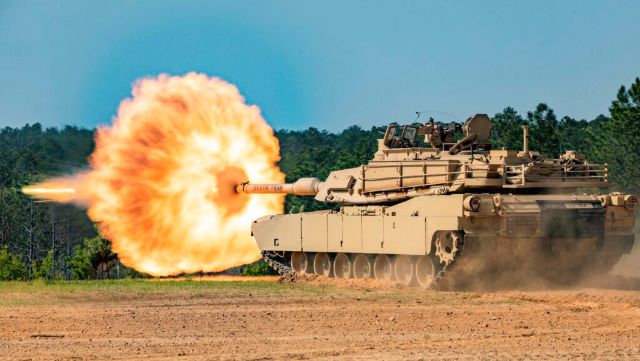By Alexey Lenkov BulgarianMilitary.com
Research conducted by Chinese scientists on the efficacy of kinetic energy weapons (KEWs) against US military tanks has revealed stunning results. In these tests, a tank could potentially be incapacitated by a single strike from a KEW, with no apparent external damage.
Reports from Chinese media sources cited that a solid sphere weighing 20kg and traveling at quadruple the speed of sound could indeed pose a formidable risk to highly advanced tanks matching the standards of the U.S. military. Such a projectile would carry roughly 25 megajoules of kinetic energy – a seemingly significant figure. In terms of electricity, it would only translate to slightly above 7 kilowatt-hours.
Despite appearing minimal, this amount of energy has the potential to cause catastrophic damage to the tank's internal system while leaving its outer shell untouched, claimed the report.

While the U.S. tank was not named outright by the Chinese researchers, they did hint that the energy in question was more than enough to wreak havoc on a U.S.-operated tank weighing between 40 to 60 tons, the Abrams tank for example.
During their research, the team deduced that impact from such projectiles could fracture critical parts of the tank, such as the bolts that affix crucial equipment to the interior cabin wall, thereby rendering the tank useless.
The findings, which were published in the peer-reviewed journal Equipment Environmental Engineering on December 8, significantly highlight the susceptibility of conventional military equipment to progressive weapons technology.

The researchers state that the impact of high-velocity kinetic projectiles can result in failure at specific armored target locations, exceeding safety thresholds set by the U.S. military standard MIL-STD-810.
MIL-STD-810, or Military Standard 810, encompasses a set of testing procedures and guidelines issued by the United States Department of Defense (DoD) to ascertain the robustness and endurance of equipment.
The chief aim of MIL-STD-810 is to ensure that military hardware remains functional under all conceivable circumstances it might encounter during its deployment. Given the recent advancements in hypersonic weaponry, defense systems often fall short in terms of response time to counter such swift attacks.

Unlike conventional anti-tank weapons that rely on gunpowder, high-speed kinetic projectiles can potentially cause fatal damage even upon slight contact. Furthermore, these projectiles can be launched in a myriad of ways, thereby increasing their applicability in different scenarios.
The Chinese researchers also found that the assessment of damage from kinetic projectiles greatly differs from that of conventional armor-piercing rounds.
Traditional rounds can be evaluated using an alloy armor piece, however, when it comes to kinetic projectile impact, the entire tank must be considered due to the complex shockwave generated at the point of impact. This shockwave could cause stress concentration points at places like bolts, leading to deformation or fracture.
Transforming the nature of warfare
Kinetic energy projectiles thrive on high terminal velocities, infusing their targets with an amount of energy that far exceeds the inherent energy found in their chemical explosives.
Tank operators tend to position the front of their vehicle towards possible threats, utilizing its robust build for protection. However, the impact of a kinetic energy projectile on this area can deliver destructive forces that penetrate the tank's interior and potentially compromise its firepower abilities.

The consequences of such an impact, as identified by researchers, could be quite alarming. The tank's gun stabilizer console might lose its hold, the wiring base of the console could be entirely dislodged, and connections between the turret and the fire control computer could get cut off. This could lead to a significant reduction in the tank's firepower.
In the meantime, in response to the growing race to develop hypersonic weapons, the potential creation of hypersonic kinetic-kill anti-tank ammunition seems very likely.
It's worth noting that the U.S. Army has been actively involved in these endeavors, channeling considerable resources over many years into the development of hypersonic kinetic-kill anti-tank missiles.
Lockheed Martin, a leading company based in the United States, had been dynamically engaging in the creation of the Compact Kinetic Energy Missile [CKEM]. Their primary focus was to equip selected models of the Future Combat Systems [FCS] family and already-established platforms. These include the tracked Bradley Fighting Vehicle and the Stryker, a wheeled armored vehicle.
In its operational domain, CKEM earned acclaim for its potential deadliness in Line-of-Sight conflict situations. 2007 was a significant year for the company when they demonstrated the CKEM's capabilities by testing it successfully against a stationary T-72 tank.
Through a successful trial against a T-72 tank fitted with explosive-reactive armor, CKEM demonstrated its power. With its emphasis on kinetic energy, it proved it could efficiently neutralize a target, even when confronted with sophisticated defensive systems.
However, the evolution of the CKEM initiative changed when the Pentagon decided to cease the Army's Future Combat Systems [FCS] program in 2009.
The Pentagon's decision not only signified the culmination of the FCS initiative but also put a sudden stop to the progression of the last known high-speed anti-tank missile project. As a result, it halted the promising advancements of the CKEM.
Consequently, over the past decade, a noticeable lessening of public discourse on this subject has sparked inquiries about the present state of such plans.
Regardless of the apparent decrease in public focus, China's studies signal a continuing interest in hypersonic kinetic-kill anti-tank technology. This suggests the concept remains strategically relevant, especially in the ever-changing context of competitive power dynamics.
In summary, the idea of a hypersonic anti-tank missile, boasting speeds beyond Mach 5 and a kinetic penetrator, has the potential to dramatically revolutionize anti-tank capabilities.
Find the original article in its entirety on BulgarianMilitary.com.
READ NEXT: Georgia Governor Greenlights Part Of Marjorie Taylor Greene's Request


